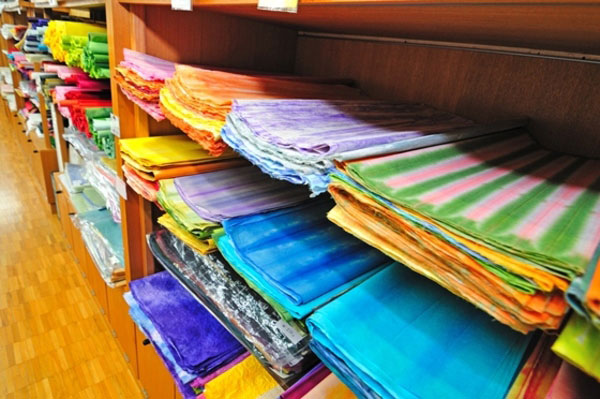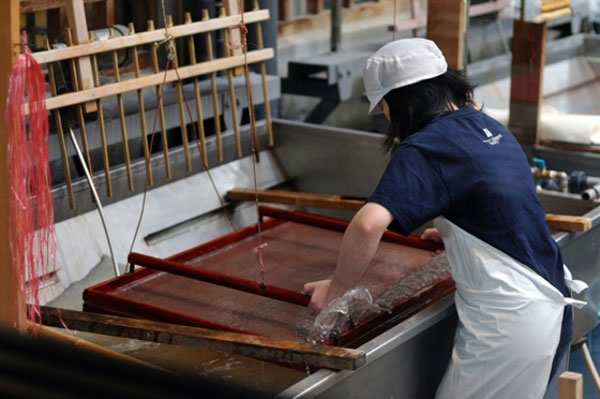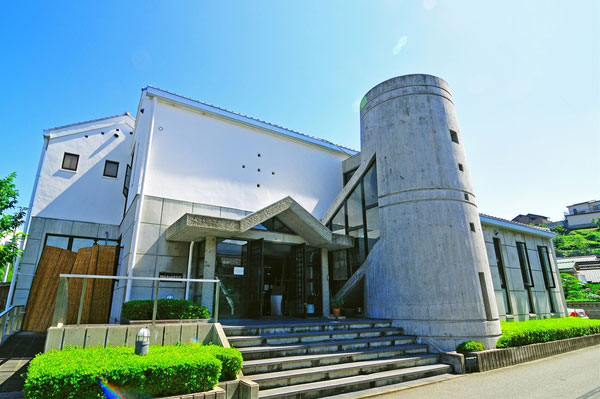
- Traditional Japanese paper
- Tokushima
Awa traditional Japanese paper Awa washi
A 1300 year-old tradition
of handmade Japanese paper
Description
What is Awa traditional Japanese paper ?
Awa washi is traditional Japanese paper made in Yoshinogawa, Naka-cho, and Ikeda-cho in Tokushima prefecture. It is produced using the traditional papermaking methods of nagashisuki (papermaking in flowing water), and tamesuki (papermaking using stored water).
This craft is known for its natural color, texture, and the handmade feel of the paper. Even though it is thin, the quality is strong as Awa washi is water-resistant and difficult to tear. The raw materials for traditional Japanese paper are the bast fibers of paper mulberry, gampi, and paperbush but hemp, bamboo, and mulberry can also be used. This craft is used in a wide range of applications with many works made from mixing with hemp or wood. It is used in watermark techniques and in items that use plant based dyes, such as the traditional industry of Tokushima indigo dyeing.
The texture of traditional Japanese paper combined with modern technology has led to the popular development of new techniques incorporating washi, such as paper for ink-jet printers, interior goods made with wire and paper, and water-resistant paper.
History

While it is not clearly defined when the production of this craft began, there are records of seventy sheaves of paper and one hundred sheaves of high quality paper being delivered to make a book about laws and customs called Engishiki which dates back to the years 806-810. Also, from records showing the cultivation of hemp and paper mulberry as well as paper production by Awa Inbeshi, a special group that grew such products for religious ceremonies, the production of Japanese paper is thought to have begun in the Nara period (710-794).
The Tokushima Domain started to put effort in producing paper, starting with Iemasu HACHISUKA the first lord of Tokushima who arrived in the region in 1585 and began to encourage the protection of the paper mulberry. In 1636, the next feudal lord encouraged farmers to produce paper for extra income. In addition, a national monopoly system defining local specialties was introduced between the years of 1716-1736 and the Tokushima paper production industry became popular and well-known throughout the country.
Due to the trend towards Westernization from the beginning of the Meiji period, a gradual decline in Awa washi began. However, one papermaking company continued to protect the tradition of this craft, which was designated as a traditional handicraft in 1976.
Production Process

- 1. Boiling and aging
The raw paper mulberry material is harvested in November and December. The bast outer bark has a three-layer structure consisting of black bark, blue bark, and white bark, so the bark is first stripped and then dried in either black bark and white bark.
After soaking the dried paper mulberry for a day in running water, the black bark and impurities remaining in the fibers are washed away. Next, the materials are boiled in alkaline solutions such as calcium hydroxide, sodium carbonate, or sodium hydroxide. Then, the fibers are boiled for about two hours, while turning them over to make sure that they are boiled evenly and softened until tearable with hands.
- 2. Cleaning
After boiling, the fibers are left overnight and steamed. After steaming, lye is removed by soaking in running water and anything other than the fiber that is soluble in the alkaline solution is removed. Then, in a basket immersed in water, any debris, irregularities, or discoloration is carefully removed from the fibers.
- 3. Beating
After cleaning, the fibers are in a bundle and each strand of fiber is separated on a stone slab or hardwood board in a process called beating. This work is no longer done by hand but done with a power mortar instead.
- 4. Papermaking
The traditional method of making washi paper, nagashisuki, consists of the three processes.
The first process consists of pouring and spreading the fibers out on the whole wooden framed sieve. In order to spread the fibers thinly and evenly over the whole sieve, it needs to quickly be filled to a shallow level with liquid fiber material. Next, layers are made in the intertwined fibers. More of the liquid materials are poured in than for the previous process and the sieve is moved around to intertwine the fibers. This step is repeated until the required thickness of the fibers is achieved. After that is achieved, the water in the sieve and the materials that are no longer required are discarded in the next step. When nagashisuki is complete, the liquid paper is removed from the sieve and laid on boards for the paper while being careful not to let air bubbles enter. The paper made by overlaying each moist sheet is called a paper bed.
- 5. Pressing
The paper bed is left as it is overnight. After the moisture has dried naturally, it is placed between wooden boards and dehydrated with a press.
- 6. Drying
After pressing, each piece of paper is individually pasted on a drying board and dried by leaving the drying board in the sun or using steam in a drying machine.
When drying is complete, dosa, konjac, or persimmon is pasted on the paper based on the desired effects. Dosa, which is made from alum and animal glue, prevents color from running, konjac waterproofs and strengthens the paper, and persimmon is used as a preservative, insect repellant, and deodorant. Also, if the paper has been dyed with indigo or if crepe-like paper is being made, those processes are done at this step.
Facility Information
Tokushima Bussan Kanko Koryu Plaza"Arudeyo Tokushima"

-
Address
-
Tel.+81-88-342-6120
-
ClosedMondays (museum open on Monday it is a holiday but closed the next day)
-
Business Hours9am to 5pm
-
Website
Other Traditional Japanese paper
- Mino traditional Japanese paper
- Echizen traditional Japanese paper
- Tosa traditional Japanese paper
- Sekishu traditional Japanese paper
- Inshu traditional Japanese paper
- Awa traditional Japanese paper
- Ozu traditional Japanese paper
- Echu traditional Japanese paper
- Uchiyama Japanese paper































































































































































































































































































